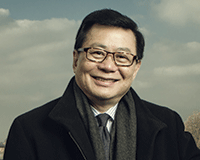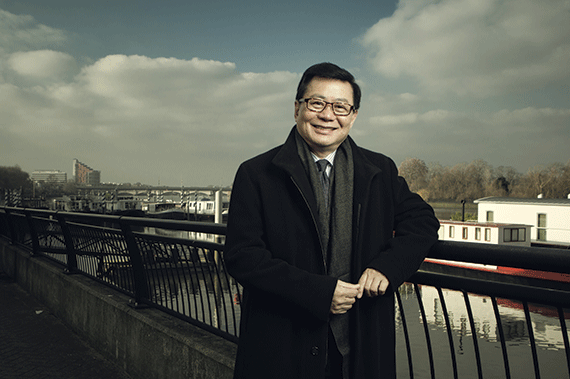Doctors and developers have a lot in common, says the GP chairman of Frasers Property. Here he tells Emily Wright why it is time to move away from luxury residential in London, explains how to save a packet on air travel and reflects on the multi-award-winning Sydney tower that makes him happy.
Portrait by Will Bremridge
Travel plans dominate in the world of Dr Stanley Quek. Every January the Singaporean GP turned property developer kicks off the year with a mass purchase of return flights. Only then can he start to plan the logistics of an existence which requires him to divide his time between three countries, two Jaguars and a Mercedes.
But those airline tickets are not booked on a whim. That is not the Quek way. Rather the former child bridge prodigy takes a meticulously strategic approach. “My family is in Singapore but my work is split between Australia and London,” says the 65-year-old over a glass of warm water “to beat the cold” on a bitter January morning on site at his £40m Riverside Quarter development, SW18.
“I book my flights all at once – this year it was 13 – but I carefully select where I go to do so. If the pound is weak one year then I will purchase them in London. Now it looks like the Australian dollar is about to weaken. So it might be wise to purchase my 2016 tickets there next year. I save tens of thousands of pounds a year doing things this way. You see how that works?” He pauses and breaks out into a wide, almost proud, grin. “I study economic performances and use currency play in the acquisition of my air tickets.”
It soon becomes clear that such genuine excitement over careful, measured strategic thinking has driven much of Quek’s success. Now the chairman of residential developer Frasers Property, Quek is responsible for part of the Singaporean parent company Frasers Centrepoint which has assets of around S$11.4bn (£5.6bn) across London, Australia and New Zealand including One Central Park in Sydney – a Tetris-esque creation with giant mirrors and an LED heliostat – which was named the best tall building of 2014 by the Council of Tall Buildings and Urban Habitat.
In London, he is best known for luxury residential developments including Vauxhall Sky Gardens, SW8, and Stanhope Gardens, SW7.
But that is all set to change. As the UK capital’s housing market continues to heat up, Quek is preparing to go down a different route.
Here he reveals what is next on his London development hit list, talks Sydney successes and explains why being a doctor and a property developer are more similar than people might think.
Changing tack
Frasers Property has been operating in the UK for just over 20 years, but Quek says it is now time to change tack. “We are competing with so many new entrants now,” he says. “There is so much new money coming in. Much of it from overseas investors aimed at high-end residential. That is why I want to focus more on delivering good, affordable houses in Greater London rather than more traditional central areas where it has got really out of hand.”
While he insists the group won’t venture too far outside of the M25 for a while yet – Frasers did have a regional office in Manchester but closed it in 2008 – the focus will be affordable fringe development rather than prime central luxury. “We are moving down the rent figures to a far more comfortable price,” he says. “We have come down from between £2,000 and £3,000 per sq ft, more even, on projects in South Kensington to £800-£1,500 per sq ft. Here at Riverside Quarter we are selling for less than £1,000 per sq ft.”
Quek adds that he does not see a demand for stacks of luxury in London and the UK’s domestic markets. And despite being a Singaporean developer heading an Australian property group backed by Thai money, he insists he is developing for Londoners.
“To be a sustainable developer here you have to cater for the local market,” he says. “We are not catering for international buyers. And so we need to move further out and away from our old hunting ground. We have looked at Teddington and Camberwell. We are looking to build 200-300 units a year and will continue to look at the south-west of the city, up to the north and maybe out east. But all areas near stations and, where possible, on the water.”
He says that he considers himself lucky to have bought some of his more central, high-end projects, such as Vauxhall Sky Gardens, some time ago. The project is due to complete by the end of 2016 and every flat has been presold. But Quek says he has major concerns about the Nine Elms scheme overall. “That scheme should be taller with much more green incorporated. It is too squat and too low. And there is a problem in general that a lot of what is being built in London is not what is required.”
He will not be drawn on whether this is as a result of his fears about overseas money pushing up values on high-end residential but he does make the point that many global investors and developers might not fully understand the inner workings of the property market in the UK in general and London in particular.
“The UK is often viewed from far away by a lot of rich companies with money to spend,” he says. “Some funds and investors settle the next generation where they can. A daughter at university in the UK, a son in Australia, and they use them for market intelligence. But do they really understand the basics of the market? I’m not sure. And I think it will spread as prices in London rise and the overseas companies start to look to the regions and to Manchester, Birmingham, Liverpool. Not unlike the shift we have seen into China’s second tier cities.”
“A lot of the skills you need to be a good doctor are the same for a good developer”
Over to Oz
But while Quek might be focusing on London for the foreseeable future, it would be remiss not to mention the Sydney project that scooped the 2014 tall building award. Now also nominated for MIPIM 2015 residential development of the year, the Jean Nouvel-designed 33-storey tower has captured attention around the world.
The striking shape is not just for show. Mirrors on the lower roof reflect sunlight onto the heliostat, which has a triple purpose. First it reflects the mirrored sun rays onto the ground below, eliminating any shadow the building would usually cast. Then it acts as a solar panel to power various elements of the building, contributing to its six-green-star rating. And finally it is considered a piece of public art at night thanks to the 2,500 coloured LED lights which from a pattern on the underside of the platform – colour coordinated with the backdrop in the property’s entrance lobby season by season.
The building also boasts a 100m high sky garden and the highest vertical gardens in the world – comprising 7km of planter boxes – masterminded by French artistic botanist Patrick Blanc.
“We spent an extra A$8m (£4.1m) on public art just on this one building,” says Quek, proudly shuffling through a stack of images of the project taken from different angles and in varying lights. “And with all the sustainable extras – including a plant to covert sewage water into reusable water – the cost of the scheme increased by about 8% to A$80m. But we made that back. It’s a 60,000 sq ft building with 18,000 sq ft of commercial space and 628 apartments which have all sold. So I am happy. That building makes me happy.”
The best medicine
And it is true that Quek does come across as more relaxed, perhaps even more content than many of his developer peers. And he gives the distinct impression that, while the success of his company and a couple of big awards might have a fair amount to do with this, it is partially down to a natural pragmatism.
“Property goes up and it goes down. You never really know if you will make money or see good returns. It is a bit like medicine in that way. You can never predict anything for sure. And actually a lot of the skills you need to be a good doctor are the same for a good real estate developer. You must be passionate, patient, exceptionally well trained. You need highly developed soft skills, like being a good communicator. And you need to be able to handle difficult situations, make hard decisions and both face and give the bad news as well as the good. You need very similar qualities.”
Those and a meticulously strategic approach, of course.












